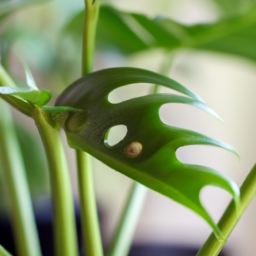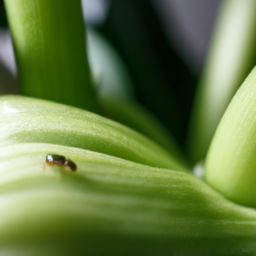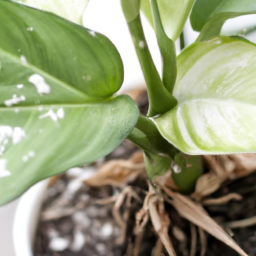
Have you ever wondered, “Will indoor plants attract bugs?” If you’re considering bringing some greenery into your home but are worried about the potential for unwanted visitors, you’re not alone. Indoor plants can indeed attract bugs, but before you dismiss the idea of having a mini jungle in your living room, let’s explore the factors that contribute to this issue. In this blog post, we’ll delve into the reasons why indoor plants may attract bugs, the types of pests you might encounter, and most importantly, how to prevent and manage any potential infestations. So, if you’re ready to learn how to maintain a bug-free indoor garden, keep reading!
Understanding the Relationship Between Indoor Plants and Insects
Indoor plants not only add a touch of beauty and freshness to our homes, but they also provide numerous benefits for our well-being. However, one concern that often arises when it comes to indoor plants is whether they attract bugs. In this guide, we will delve into the relationship between indoor plants and insects, providing you with an analytical perspective and a step-by-step understanding of this topic.
Why Do Bugs Find Indoor Plants Attractive?
Before we dive into whether indoor plants attract bugs or not, it is crucial to understand why bugs are naturally drawn to plants. Insects, such as aphids, mealybugs, and spider mites, are primarily attracted to plants due to their need for food and shelter. Plants offer a source of sustenance, as they contain vital nutrients and moisture that insects require to survive. Additionally, plants provide a safe haven for bugs, shielding them from predators and extreme weather conditions.
When we bring indoor plants into our homes, we inadvertently create an environment that mimics the natural habitat of insects. The warmth, humidity, and abundance of foliage in our homes make them an attractive dwelling place for bugs. However, it is crucial to note that not all indoor plants attract bugs in the same way. Some plants are more prone to attracting insects than others, depending on various factors such as their scent, nectar production, and overall health.
Factors That Influence Bug Attraction
Now that we understand why bugs find indoor plants attractive, let’s explore some factors that influence bug attraction and how you can mitigate their impact.
1. Plant Species: Different plant species have varying levels of attractiveness to insects. Some plants, such as the spider plant (Chlorophytum comosum) and the snake plant (Sansevieria trifasciata), are known for their ability to repel bugs. On the other hand, plants like the fiddle leaf fig (Ficus lyrata) and the peace lily (Spathiphyllum wallisii) are more likely to attract insects. Researching the bug-attracting tendencies of specific plant species can help you make informed decisions when choosing indoor plants.
2. Plant Health: Healthy plants are less likely to attract bugs. Insects are naturally drawn to weak and stressed plants, as they are more susceptible to infestations. To keep your indoor plants healthy and bug-free, ensure they receive adequate sunlight, water, and nutrients. Regularly inspect your plants for signs of pests or diseases and take prompt action if any issues arise.
3. Environmental Conditions: The environmental conditions in your home play a significant role in bug attraction. Insects thrive in warm and humid environments, so maintaining proper ventilation and humidity levels can discourage bug infestations. Avoid overwatering your plants, as excessive moisture can create a breeding ground for bugs. Additionally, regularly clean your plant’s leaves to remove dust and debris, which can attract insects.
Preventing and Managing Bug Infestations
While it is challenging to completely eliminate the possibility of bugs in indoor plants, there are several preventive measures and management strategies you can implement to minimize infestations.
1. Quarantine New Plants: When introducing new plants to your indoor collection, it is essential to quarantine them for a few weeks. This allows you to observe the plants for any signs of pests or diseases before placing them near your existing plants. If you notice any issues, take appropriate action to treat the affected plants and prevent the infestation from spreading.
2. Regularly Inspect Your Plants: Conduct routine inspections of your indoor plants to identify any signs of bug infestations. Look for visible pests, such as aphids or spider mites, as well as indicators of infestation, such as yellowing leaves, distorted growth, or sticky residue. Early detection can help you address the issue promptly and prevent it from spreading to other plants.
3. Natural Remedies and Biological Controls: If you notice a bug infestation, consider using natural remedies or biological controls to manage the problem. For example, introducing beneficial insects like ladybugs or lacewings can help control aphid populations. Neem oil, insecticidal soaps, and homemade vinegar solutions can also be effective in treating certain pests. However, it is crucial to research and follow proper application methods to ensure the safety of your plants.
4. Chemical Treatments: In severe cases, chemical treatments may be necessary to eliminate persistent bug infestations. However, it is essential to exercise caution when using pesticides indoors, as they can be harmful to humans and pets. Always read and follow the instructions provided by the manufacturer, and consider consulting a professional if you are unsure about the appropriate use of chemical treatments.
By implementing these preventive measures and management strategies, you can significantly reduce the likelihood of bug infestations in your indoor plants. Remember, maintaining a healthy and thriving indoor plant collection requires ongoing care and attention.
Conclusion
Indoor plants can indeed attract bugs, but with proper understanding and proactive measures, you can minimize the risk of infestations. By considering the bug-attracting tendencies of different plant species, maintaining plant health, and creating an environment that is less favorable for bugs, you can enjoy the beauty and benefits of indoor plants without the worry of unwelcome visitors. Remember to regularly inspect your plants, quarantine new additions, and employ natural or chemical treatments when necessary. With these steps, you can create a bug-free haven of greenery in your home.

Will Indoor Plants Attract Bugs?
Indoor plants not only beautify our living spaces but also provide numerous health benefits. However, one concern many plant enthusiasts have is whether indoor plants attract bugs. The short answer is yes, indoor plants can attract bugs, but with proper care and preventive measures, you can easily manage and minimize any bug-related issues.
Common Bugs Attracted to Indoor Plants
1. Fungus Gnats:
Fungus gnats are tiny flying insects that are commonly found around indoor plants. They are attracted to moist soil and decaying organic matter. Fungus gnats can be a nuisance, but they do not cause significant harm to the plants. To deal with fungus gnats, follow these steps:
– Allow the soil to dry out between waterings, as fungus gnats thrive in moist conditions.
– Use yellow sticky traps to catch adult fungus gnats.
– Avoid overwatering and remove any decaying plant material from the soil.
2. Aphids:
Aphids are small insects that feed on plant sap, causing damage to the leaves and stems. They can be found on the undersides of leaves and reproduce rapidly. To control aphids:
– Inspect your plants regularly and manually remove any visible aphids with a gentle spray of water or by wiping them off with a soft cloth.
– Introduce natural predators like ladybugs or lacewings, which feed on aphids.
– Use insecticidal soap or neem oil as a last resort if the infestation is severe.
3. Spider Mites:
Spider mites are tiny pests that suck the sap from plant leaves, causing yellowing and webbing. They thrive in warm and dry conditions. To combat spider mites:
– Increase humidity around your plants by misting them regularly or placing a tray filled with water nearby.
– Use a strong jet of water to dislodge spider mites from the leaves.
– Apply insecticidal soap or neem oil to control severe infestations.
Preventive Measures to Minimize Bug Infestations
1. Choose the Right Plants:
Some plants are more prone to attracting bugs than others. Research the specific plants you want to bring indoors and select ones that are less likely to attract pests.
2. Inspect New Plants:
Before introducing a new plant to your indoor collection, thoroughly inspect it for any signs of pests. Look for webs, eggs, or tiny insects on the leaves and stems.
3. Quarantine New Plants:
Keep new plants separate from your existing indoor plants for a few weeks to ensure they are bug-free. This will prevent any potential infestations from spreading.
4. Maintain Good Plant Hygiene:
Regularly clean your plants by wiping the leaves with a damp cloth to remove dust, debris, and any potential pests.
5. Avoid Overwatering:
Overwatering not only attracts fungus gnats but also creates a favorable environment for other pests. Water your plants only when the top inch of soil feels dry.
6. Provide Adequate Light:
Proper lighting conditions can promote healthy plant growth and discourage pests. Ensure your indoor plants receive the right amount of light based on their specific requirements.
By following these preventive measures and promptly addressing any bug infestations, you can enjoy the beauty and benefits of indoor plants without worrying about attracting unwanted pests. Remember, a little care goes a long way in maintaining a bug-free indoor garden!

Will Indoor Plants Attract Bugs
Indoor plants not only add beauty and freshness to our living spaces but also provide numerous health benefits. However, one concern that often arises is whether indoor plants attract bugs. While it is possible for bugs to be attracted to indoor plants, there are several steps you can take to prevent bug infestations and keep your indoor plants healthy and thriving. In this guide, we will explore some effective tips for preventing bugs from infesting indoor plants.
Understanding Why Bugs are Attracted to Indoor Plants
Before we delve into the preventive measures, it’s essential to understand why bugs are attracted to indoor plants in the first place. Indoor plants offer a perfect environment for bugs to thrive due to the favorable temperature, humidity, and abundance of food sources. Bugs such as aphids, spider mites, fungus gnats, and mealybugs are commonly attracted to indoor plants.
Aphids are tiny insects that feed on the sap of plants, causing wilting and yellowing of leaves. Spider mites are microscopic pests that suck the sap from plant leaves, resulting in stippled or discolored foliage. Fungus gnats are small flies that lay their eggs in the potting soil, and their larvae feed on plant roots. Mealybugs are soft-bodied insects that leave a white, cotton-like residue on plant stems and leaves.
Now that we understand why bugs are attracted to indoor plants, let’s explore some effective tips to prevent bug infestations.
1. Choose Healthy Plants
One of the best ways to prevent bug infestations is to start with healthy plants. When purchasing indoor plants, carefully inspect them for any signs of pests or diseases. Look for yellowing leaves, webbing, sticky residue, or any visible bugs. It’s also a good idea to buy plants from reputable nurseries or garden centers that have a reputation for providing healthy plants.
Additionally, avoid overcrowding your indoor space with too many plants. Overcrowding can create a favorable environment for pests to multiply and spread quickly. Give your plants enough space to grow and ensure proper air circulation between them.
2. Maintain Proper Hygiene
Keeping your indoor plants clean and free from debris is crucial in preventing bug infestations. Regularly remove dead leaves, fallen flowers, and any decaying organic matter from the soil surface. These materials can attract pests and provide a breeding ground for bugs.
Furthermore, regularly wipe down the leaves of your plants with a damp cloth to remove dust and potential hiding spots for bugs. This will not only keep your plants looking fresh but also make it harder for pests to establish themselves.
3. Inspect and Quarantine New Plants
When introducing new plants to your indoor space, it’s important to inspect them thoroughly for any signs of pests. Look closely at the leaves, stems, and undersides of the leaves for any visible bugs or eggs. If you notice any signs of infestation, isolate the new plant from your existing ones to prevent the spread of pests.
Quarantining new plants for a few weeks is a good practice, even if they appear healthy. This allows you to closely monitor them for any signs of pests that may have gone unnoticed during the initial inspection. If the new plant remains pest-free after the quarantine period, you can safely integrate it with your other indoor plants.
4. Provide Optimal Growing Conditions
Creating and maintaining optimal growing conditions for your indoor plants can significantly reduce the risk of bug infestations. Most pests thrive in environments with high humidity, so it’s important to keep the humidity levels in check. Avoid overwatering your plants and ensure proper drainage to prevent waterlogged soil, which can attract pests.
Additionally, provide adequate sunlight to your plants based on their specific light requirements. Healthy plants are less susceptible to pests, so it’s crucial to meet their light, temperature, and humidity needs.
5. Regularly Check for Signs of Infestation
Even with preventive measures in place, it’s important to regularly inspect your indoor plants for any signs of infestation. Look for yellowing or wilting leaves, discolored foliage, webbing, sticky residue, or any visible bugs. Early detection is key in preventing the spread of pests and minimizing potential damage to your plants.
If you notice any signs of infestation, take immediate action to control and eliminate the pests. There are various organic pest control methods available, such as neem oil, insecticidal soaps, or introducing beneficial insects like ladybugs that feed on pests.
In conclusion, while indoor plants can attract bugs, following these preventive tips can help you maintain bug-free and healthy indoor plants. By choosing healthy plants, maintaining proper hygiene, inspecting and quarantining new plants, providing optimal growing conditions, and regularly checking for signs of infestation, you can enjoy the beauty and benefits of indoor plants without the hassle of bug problems.
Summary Snapshot
Indoor plants are a great way to bring a touch of nature into our homes, but one concern that often comes up is whether they will attract bugs. It’s a valid question, as the last thing we want is to bring pests into our living spaces. However, the good news is that, in most cases, indoor plants are unlikely to attract bugs.
Many insects are attracted to outdoor plants because they rely on them for food and shelter. However, indoor plants typically don’t provide the same conditions that bugs are looking for. Most insects prefer to be outside where they can find a variety of plant species to feed on and reproduce. Indoor environments tend to be less appealing to bugs due to the absence of natural elements like soil, moisture, and sunlight that sustain their life cycles. Additionally, the controlled temperature and lack of exposure to natural elements make it harder for insects to survive indoors.
Here are this week’s Top Questions and Answers
Q1: Will indoor plants attract bugs?
A1: It is possible for indoor plants to attract bugs, but it is not always the case. While some plants may attract certain types of insects, most indoor plants do not attract bugs unless they are already infested or not properly cared for. By following proper plant care practices, you can minimize the chances of attracting bugs to your indoor plants.
Q2: What can attract bugs to indoor plants?
A2: Several factors can attract bugs to indoor plants. Overwatering or allowing the soil to remain consistently damp can create a favorable environment for pests like fungus gnats. Lack of proper air circulation, excessive humidity, and poor lighting conditions can also make plants more susceptible to insect infestations. Additionally, bringing outdoor plants or cut flowers indoors without inspecting them for pests can introduce bugs to your indoor space.
Q3: How can I prevent bugs from infesting my indoor plants?
A3: To prevent bugs from infesting your indoor plants, there are several measures you can take. First, ensure that you are providing optimal care for your plants, including proper watering, adequate lighting, and good air circulation. Regularly inspect your plants for any signs of pests, such as webs, sticky residue, or tiny insects. If you spot any pests, isolate the affected plant and treat it with appropriate organic or chemical pest control methods. Avoid over-fertilizing your plants, as excessive nutrients can attract pests. Lastly, avoid bringing outdoor plants or flowers indoors without thoroughly checking them for bugs.
Q4: Are there any indoor plants that naturally repel bugs?
A4: Yes, there are several indoor plants that are known to naturally repel bugs. Some common examples include citronella, lavender, basil, mint, rosemary, and marigold. These plants contain natural compounds that insects find repulsive, helping to keep them away from your indoor space. However, it is important to note that while these plants may act as deterrents, they are not foolproof solutions and may not completely eliminate the presence of bugs.
Q5: What should I do if my indoor plants are already infested with bugs?
A5: If you discover that your indoor plants are infested with bugs, it is important to take immediate action to prevent the infestation from spreading. Start by isolating the affected plant to prevent the bugs from spreading to other plants. Depending on the severity of the infestation, you can try various pest control methods, such as using insecticidal soaps, neem oil, or introducing natural predators like ladybugs. If the infestation persists or becomes unmanageable, it may be necessary to dispose of the affected plant to protect the health of your other indoor plants.

James Wong is a renowned ethnobotanist, plant scientist, and local television presenter. With a passion for demystifying plant science, he is known for translating complex botanical concepts into practical advice for everyday plant enthusiasts. James’s expertise spans from traditional gardening to cutting-edge plant technologies, making his insights accessible and informative.


